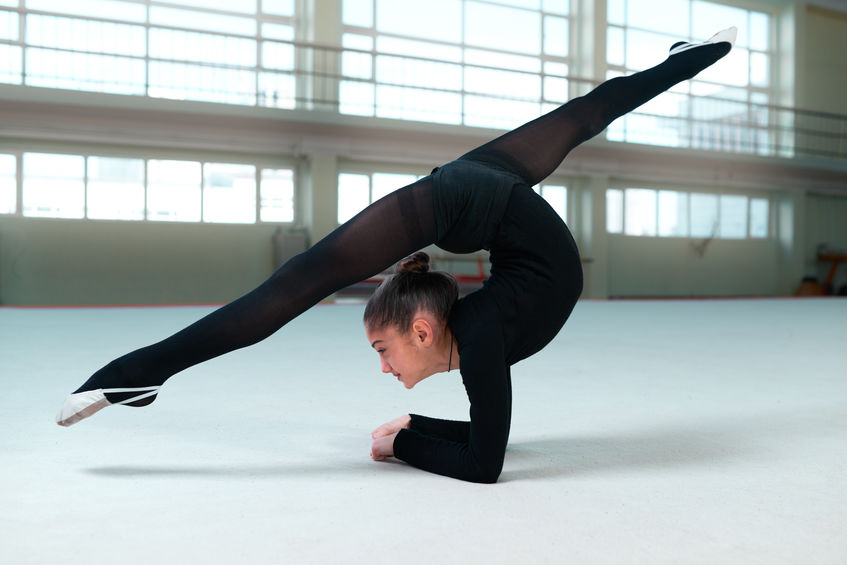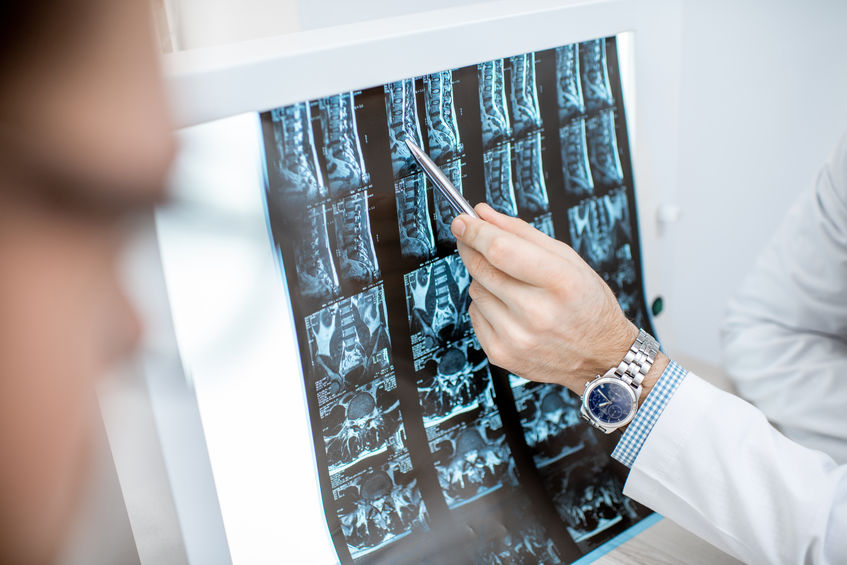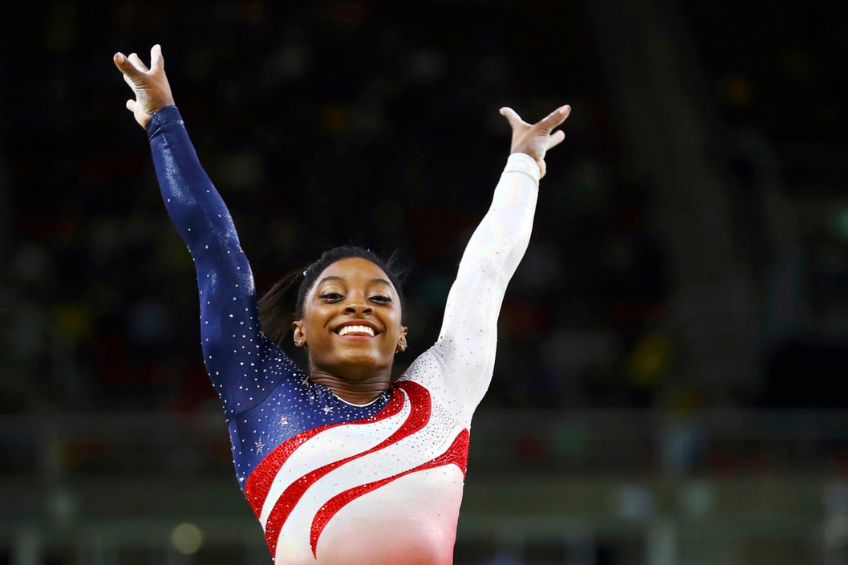Can Scoliosis & Gymnastics Go Together?
My niece Eva is an aspiring gymnast who enjoys displaying her talents at home or in inter- school competitions. Her posture is so straight and tall that I was wondering if gymnastics or other types of sports such as ballet or swimming would be beneficial for kids suffering from scoliosis. It seemed logical that stretching the back and balancing on beams might have a positive impact on a scoliosis sufferer her age. Eva is now twelve and I am so pleased with the way she carries herself. I always believed that the reason for her straight posture was all the exercising and stretching that she performed on a regular basis at her gym classes.

Gymnasts such as Eva practice a wide range of exercises from foot splits to sophisticated flips and other extreme muscular movements. She spends lots of her time at the local gymnastics studio (two-hour sessions twice a week plus practice at home.) Some of her moves include horizontal, uneven, and parallel bars, and balance beams.
Childhood scoliosis sufferers whose curves are reasonably low can sometimes beat the brace by physical therapy or else undergo a combination of bracing and physical therapy simultaneously. After checking out a few websites on the relationship of gymnastics and scoliosis I was quite surprised and disturbed by the different opinions of professionals in the scoliosis field. Some were adamantly against any kind of movements that required stretching and balancing exercises for scoliosis sufferers while others were okay with gymnasts who were diagnosed with scoliosis continuing their gymnastics interest.
What really floored me was that basically all the articles that I read gave alarming statistics that gymnasts had a higher incidence of scoliosis than the general population. That is not to say that scoliosis is brought on by gymnastics only that some types of motions can sometimes intensify the already present issues. The recreational types of gymnastics should not cause problems however the more sophisticated and professional moves like landing on hard ground or extended stretches can negatively impact the spinal curvature already present.
Athletes such as swimmers, dancers, and gymnasts repeatedly lengthen their thoracic spines. For example, the back bend involves thoracic spine lengthening which can make the vertebrae turn and move deep down into an opening that is part of the already present scoliosis curve. Another athletic concern is spinal compression which is the result of hard landings on the floor. Whenever a child runs or actively applies lots of tension on the spine, the scoliosis problem can become worse.
As a concerned aunt I wanted to make sure Eva was not doing anything to exacerbate an innate problem that her family was not aware of. I realized that with the tight-fitting uniform that adorns a typical female gymnast it would be easy to spot the signs of scoliosis, some of which are, protruding ribs, uneven shoulders, and spine curvature. I wondered if the instructors were advised to look out for these imperfections in their students. In lots of schools there is a mandatory medical check-up that is performed to watch out for this condition in all students. With some kids wearing loose t-shirts or sweatshirts it would be hard to ascertain who has what. But I would think that any gym instructor should be advised to look out for scoliosis in their charges if it’s true that scoliosis is more prevalent in gymnasts.
These are some of the symptoms that parents, teachers and recreational and sports instructors should be aware of: single hip protrusion, shoulder not level or protruding, a tilt of the head or clothing that is not laying properly on the body.
According to the UK Scoliosis Clinic, gymnasts are up to twelve times more inclined to develop scoliosis than non-gymnasts. Rhythmic gymnasts are ten times more likely to develop scoliosis than the general population and ballet dancers have a 24% prevalence of scoliosis.
Why should this be so? Some point out that scoliosis patients have a higher incidence of joint laxity than the general population at large making them more flexible and therefore able to perform moves that other find remarkably difficult to fathom.
What happens when you have a young nine-year-old girl who absolutely loves gymnastics? Such a girl is Ellie Ruth. Ellie was diagnosed with scoliosis when she was just nine and her parents had several choices to deal with. I would actually call them dilemmas. We all encourage our children to make the right choices in the sports activities they participate in and Ellie’s parents were no different. With such a talented and agile candidate why wouldn’t they encourage her passion for gymnastics?
Finding the right specialist in their hometown of Richmond, Victoria, Australia was no easy feat. But search they did and found a wonderful scoliosis specialist, Dr. Kris Lundine associated with Epworth hospital in Richmond who began treatment immediately. Although bracing is usually a full-time treatment, this doctor used a different approach with nighttime treatment with the Rigo-Chêneau Brace and Schroth therapy. Although some doctors discourage the continuation of any extreme sport, Ellie’s doctor used gymnastics to her advantage and encouraged Ellie to stay strong in her core. Although her curve still needs improvement in terms of degrees, she is continuing her vigorous gymnastics schedule. She visits her doctor every six months and so far, there is no reason for the dreaded spine surgery that some specialists recommend. Ellie is competing in many competitions across Melbourne, Australia and has racked up 15 medals as of this writing. Ellie is living proof that you can continue the rigorous regiment of gymnastics while combating the serious condition of scoliosis. Our hats off to Ellie.

It is still up in the air as far as a universal opinion of allowing athletes such as gymnasts to continue their routines while being treated for scoliosis. Each specialist will have their own treatment plans. The majority of children with scoliosis have curves that are relatively subtle.
Bracing and physical therapy along with their regular sports routine works out fine. In fact, there are some professionals who believe that physical activity lowers the risk of scoliosis progression.
There are many good reasons for an athlete with scoliosis to keep their normal sports routine. Positive impacts on the health of a scoliosis patient from continued sports participation including gymnastics include increased bone density, increased aerobic power and of course cardiovascular health. And don’t forget the patient’s very important self-image. Scoliosis patients who exercise regularly have higher self-esteem and are healthier psychologically at the conclusion of their treatment. It’s hard enough to wear a brace and sometimes have to change a child’s wardrobe to a looser style. Taking away their favorite passion is certainly not beneficial neither to their physical or emotional well-being.

Rebecca Best is a famous gymnast who began competing when she was only five years old. Rebecca’s was diagnosed with scoliosis in 2005 with a curvature of about 40 degrees. She also suffered from back pain and wondered what the long-term effects would be to her scoliosis if she continued her gymnastics competitions. Luckily for Rebecca, her doctor did not see any reason for her to stop gymnastics and felt that the body strength that she was amassing would be beneficial for her in the long run. She has had to deal with all kinds of back pain throughout her career, but with therapy and deep tissue massage she finds the pain manageable. No wonder when someone is as passionate as Rebecca tries, she succeeds. In fact, she received a full athletic scholarship from Ohio State University in spite of knowledge that the college had regarding her scoliosis.
So, what have we learned from all these pro and con discussions and observations?
- If your child has a passion for gymnastics, find a caring specialist who will incorporate gymnastics or any other sport that they love into their scoliosis regiment.
- This may mean some modifications of their gymnastics routine temporarily or in some cases using this sport to help the patient combat their problem depending on where the problem is located, be it a hip or shoulder protrusion or the more typical spinal curve.
- Try asking the gymnastics instructor if your child could use softer surfaces for ground landings when possible.
- Let your child know that there have been many athletes who have spinal curves and have succeeded nevertheless in their particular sports arena.
Final Words
Gymnastics and scoliosis do not have to be enemies. With the right early diagnosis and treatment either with bracing, physical therapy or both, your child can continue developing her passion and excelling. A sensitive scoliosis specialist and physical therapist will develop a routine specifically geared to your child and use his or her agility for her own body’s benefit. There does seem to be some correlation with a talent for gymnastics and scoliosis, so it is crucial that parents and instructors be on the lookout for any unusual protrusions and curves. If caught early, scoliosis is much easier to treat so that none of your child’s competitions will be interrupted at all.


